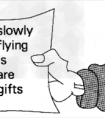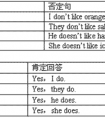选择括号内适当的单词填空。1.DavidandI(am/are)inthesameclass.David(likes/isliking)makingmodelplanes,butI(don'tlike/don't).2.MrBlackismy(first/thefirst) PEte-六年级英语
your
their
名词性物主代词
mine
yours
his
her
its
ours
yours
theirs
汉语意思
我的
你的
他的
她的
它的
我们的
你们的
他(她它)们的
This is her dress. / This dress is hers.
物主代词的用法:
物主代词既有表示所属的作用又有指代作用,例如:
John had cut his finger; apparently there was a broken glass on his desk.
约翰割破了手指,显而易见,他桌子上有个破碎的玻璃杯。
物主代词有形容词性(my, your等)和名词性(mine, yours等)两种,形容词性的物主代词属于限定词。
名词性的物主代词在用法上相当于省略了中心名词的 --'s属格结构,例如:
Jack's cap 意为 The cap is Jack's.
His cap 意为 The cap is his.
名词性物主代词的句法功能:
a. 作主语,例如:
May I use your pen? Yours works better.
我可以用一用你的钢笔吗? 你的比我的好用。
b.作宾语,例如:
I love my motherland as much as you love yours.
我爱我的祖国就像你爱你的祖国一样深。
c.作介词宾语,例如:
You should interpret what I said in my sense of the word, not in yours.
你应当按我所用的词义去解释我说的话,而不能按你自己的意义去解释。
d.作主语补语,例如:
The life I have is yours. It's yours. It's yours. 我的生命属于你,属于你,属于你。
物主代词的意思是物品主人的代词。
| 人称代词 | 第一人称单数 | 第二人称单数 | 第三人称单数 | 第一人称复数 | 第二人称复数 | 第三人称复数 |
| 主格 | I | you | he/she/it | we | you | they |
| 宾格 | me | you | him/her/it | us | you | them |
| 汉语 | 我 | 你 | 他 | 我们 | 你们 |
他/她/它们 |
| 形容词性物主代词 | my | your | his/her/its | our | your | their |
| 名词性物主代词 | mine | yours | his/hers/its | ous | yours | theirs |
| 汉语 | 我的 | 你的 | 他的/她的/它的 | 我们的 | 你们的 | 他/她/它们的 |
考点名称:形容词的最高级
- 形容词的最高级:
用于三个或三个以上的人或事物的比较,结构为:“the+形容词最高级+比较范围”,意为“最……”。
例:Tom is the youngest basketball player in our school. 汤姆是我们学校年龄最小的篮球运动员。
形容词最高级的变化规律:
1. 单音节形容词后面直接加-est
tall—tallest
fast—fastest
2. 以-e结尾的单音节形容词直接加-st
large—largest
nice—nicest
3. 以-y结尾的形容词,改-y为-i再加-est
busy—busiest
early—earliest
4. 形容词是重读闭音节时,双写最后的辅音字母,再加-est
hot—hottest
big—biggest
5. 多音节形容词前面直接加most
delicious—most delicious
beautiful—most beautiful
6. 不规则变化
good (well)—best
bad (badly)—worst - 最高级的用法:
①三者或三者以上相比,表示最高程度时,用“ the十最高级”的结构表示.这种句式一般常有表示比较范围的介词短语.例如:
Zhang Hua is the tallest of the three.
He works (the) hardest in his class.
②最高级可被序数词以及 much,by far,nearly,almost,by no means,not quite,not really,nothing like等词语所修饰. 例如:
This hat is by far/much/nearly/almost/not nearly/by no means/not quite/nothing like the biggest.
How much did the second most expensive hat coat?
③表示“最高程度”的形容词,如 excellent,extreme,perfect等,没有最高级,也不能用比较级.
④形容词最高级修饰作表语或介词宾语的名词、代词时,被修饰的词往往省略.例如:
He is the tallest(boy) in his class.
⑤作状语的副词最高级前可以不加定冠词.例如:
0f all the boys he came(the) earliest. - 形容词的原级和最高级列举:
原级 比较级 最高级 规则形容词 long longer longest large larger largest dry drier driest big bigger biggest hot hotter hottest 不规则形容词 beautiful morebeautiful most beautiful good/well better best bad worse worst many/much more most
考点名称:形容词
- 用来修饰或描述名词(或代词),表示人或事物的性质、状态和特征的词。形容词有三个比较等级:原级、比较级和最高级。
形容词的判断方法:?<?xml:namespace prefix = "o" ns = "urn:schemas-microsoft-com:office:office" />
判断一个词是不是形容词,可以从其结构特点和句法特点两方面来确定。?
(1)结构特点:?
以-able,-al,-ful,-ic,-ish,-less,-ous,-y等后缀结尾的词,一般是形容词,如:
changeable(多变的),medical(医学上的),careful(仔细的),atomic(原子的),foolish(愚蠢的),careless(粗心的),delicious(美味的),healthy(
- 最新内容
- 相关内容
- 网友推荐
- 图文推荐
| [家长教育] 孩子为什么会和父母感情疏离? (2019-07-14) |
| [教师分享] 给远方姐姐的一封信 (2018-11-07) |
| [教师分享] 伸缩门 (2018-11-07) |
| [教师分享] 回家乡 (2018-11-07) |
| [教师分享] 是风味也是人间 (2018-11-07) |
| [教师分享] 一句格言的启示 (2018-11-07) |
| [教师分享] 无规矩不成方圆 (2018-11-07) |
| [教师分享] 第十届全国教育名家论坛有感(二) (2018-11-07) |
| [教师分享] 贪玩的小狗 (2018-11-07) |
| [教师分享] 未命名文章 (2018-11-07) |






